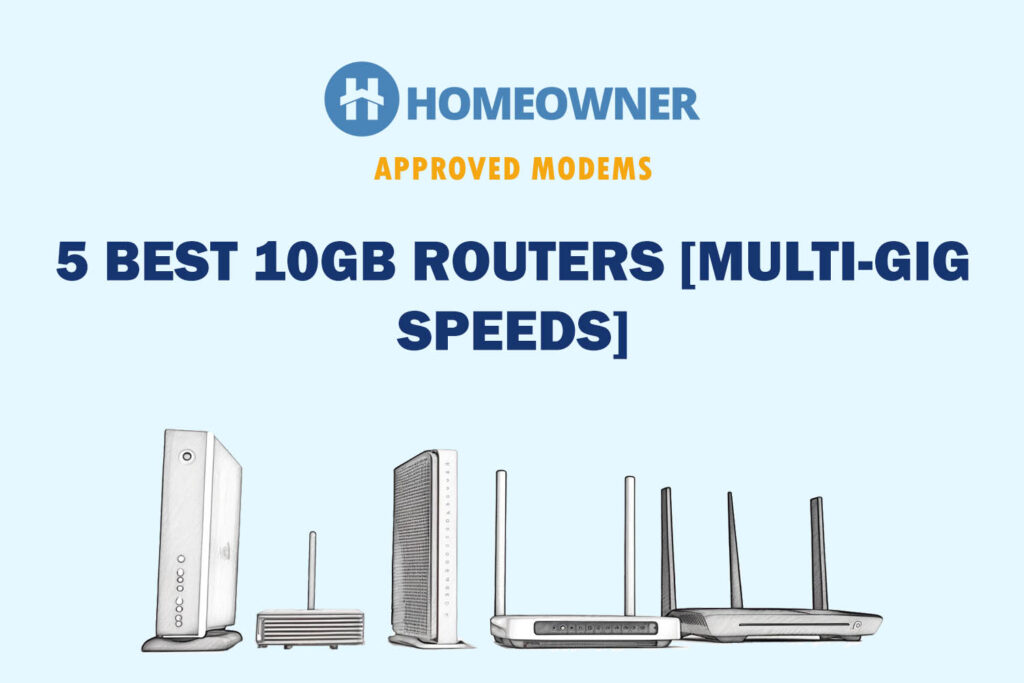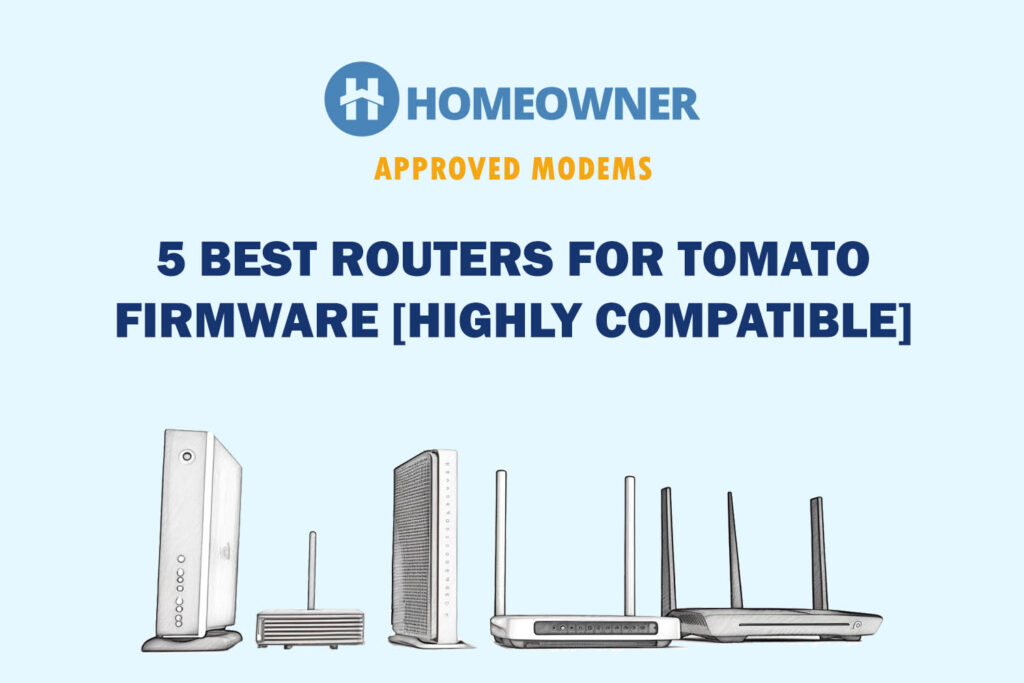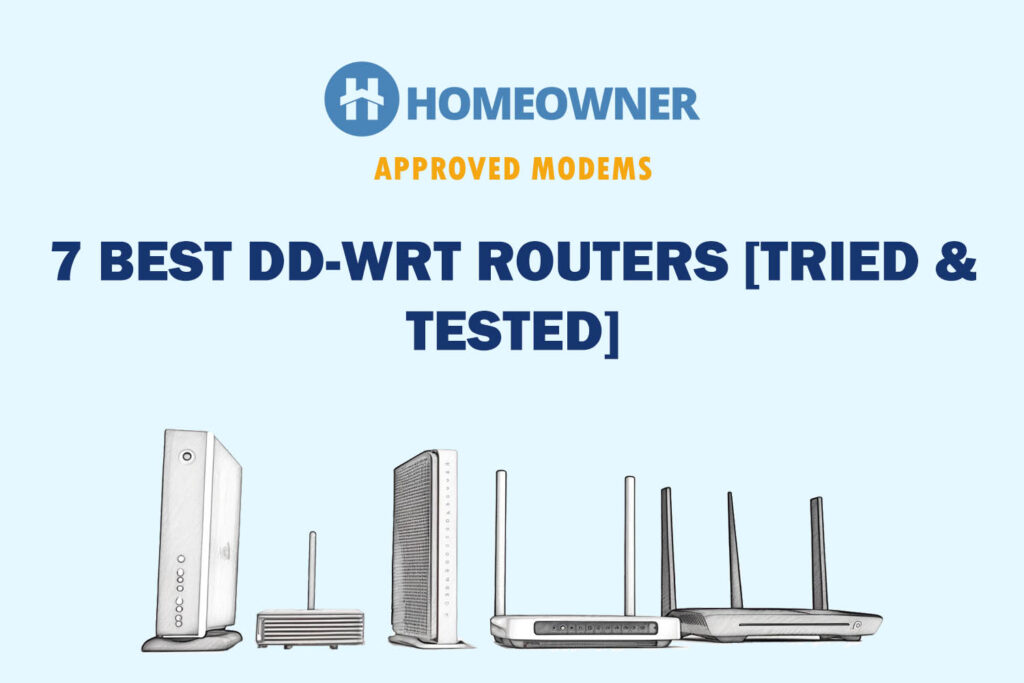Wired connections supersede wireless ones over many obvious aspects: speed, efficiency, reliability, and more. And the more ports on a router, the better it is.
Whether you need to use various network services and devices, such as printers, NAS (network-attached storage), and ethernet switches, or simply want to improve your connection's reliability or bandwidth, you've come to the right place.
I have extensive experience configuring wired connections for homes and businesses. In this article, I'll review my top picks for routers with 8 ethernet slots.
5 Best 8-Port Wireless Routers in 2025

What is the reason for considering my suggestions?
Kurt Twain
Apart from setting up networks for my clientele, I've tested nearly every multi-port router on the market.
They went through my four to five-part test, where I examined their real-time speeds, wired connectivity, signal range, security, and more.
All my recommendations are, therefore, all-rounders, establishing a perfect balance between performance and cost.
To cater to a diverse user base, I've tried including routers with different configurations and performance standards so you have enough choices. Ensure your selected device isn’t overkill or below par with your specific needs.
So don’t look elsewhere. Just sort out your needs, go through the detailed reviews, and make an ultimate decision. Let's begin without further ado!
1. Best Overall: TP-Link Archer AX11000
- TP-Link HomeCare: Protect your network and connected devices with a free lifetime subscription to TP-Link HomeCare featuring next-level antivirus, robust parental controls, and QoS
- More Devices with Less Lag: OFDMA and MU-MIMO technology deliver data to multiple devices, simultaneously
- Game Accelerator: Automatically detects and optimises your gaming streams, ensuring that your network keeps up with even the most intense action sequences
As a gamer, the last thing you need is a laggy router, so consider this TP-Link Archer AX11000. Being one of the top TP-Link routers, it has all the necessary ingredients, including multi-gig WAN, tri-band WiFi, and beefy hardware.
Taking over from Archer AX10000, there isn’t much improvement spec-wise, but it certainly improves overall performance.
Speeds & Performance
Archer AX11000 is a tri-band WiFi 6 router that comes at an aggregated speed of 11000 Mbps, shared between each band as follows:
| 5GHz (1): 4804 Mbps | 5GHz (2): 4804 Mbps | 2.4 GHz: 1148 Mbps |
With the AT&T 2 Gbps plan, the connected devices dashed off with the online tasks. Large files were downloaded in seconds at 20 feet, with download speeds of 1.71 Gbps and upload speeds of 1.35 Gbps.
While at 40 feet, although respective speeds dropped to 1.01 Gbps and 696 Mbps, gaming, streaming, video conferencing, or other tasks went like a breeze.
For gamers, there’s a game accelerator QoS that, aside from prioritizing traffic, further enhances your gaming experience by solving lag and RAM-memory issues in games. Not only speed, but I was also impressed with its consistency.
Although signal strength wasn’t great in the nooks, you won’t experience any jitters, inconsistencies, or lags.
Ports & Connectivity
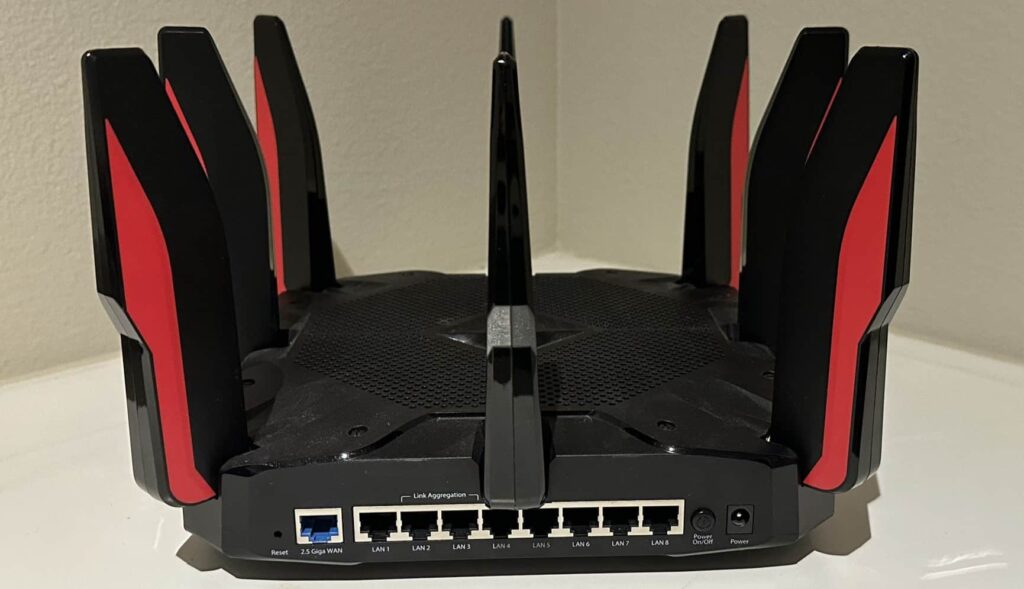
If you need multiple wired connections simultaneously, you can’t go wrong with Archer AX11000. Its rear panel has ten Ethernet ports, eight with Gigabit speed capacity and one with a maximum output of 2,500 Mbps.
A static Link aggregation feature is also available for port pairing, but you must have two separate ISPs.
The 2.5G is ideal for high-gigabit fiber and cable internet plans. So I plugged in my Dell XPS laptop to the multi-gig port and subscribed to the AT&T 2 Gbps plan, with download speeds maxed out at 1.97 Gbps.
The games were fast, with Overwatch averaging at 7ms and 112fps throughout an hour.
WiFi Coverage & Devices Capacity
Archer AX11000 seems like a great choice for any three-bedroom apartment with a stipulated range of 3,000 Sq Ft. And housing eight external antennas, it delivers impressive coverage of around 2,630 Sq Ft. The best part, however, is it maintains consistency throughout the space.
The antennas work with beamforming, MU-MIMO, and OFDMA to concentrate the signals onto the connected devices. At a stretch, I could seamlessly connect to up to 76 devices.
Security Features
With HomeShield basic security suite right out of the box, Archer AX11000 has a decent score in terms of security.
Features like WPA3, VPN, guest network, access control, and auto-firmware updates protect your network data from unwanted or malicious elements. Besides, many advanced features are available, but you must pay a subscription fee to access those.
Conclusion
Overall, AX11000 is fast and is a feature-loaded wireless router with 8 LAN ports to boost your gaming and wired connections by two to threefold. It also has eight powerful antennas to transmit stable signals over a large area.
Pros
- Gamer-friendly settings
- Static Link Aggregation
- Multi-gig WAN port
- Excellent speeds
- Great WiFi range
Cons
- Premium
2. Best Runner-Up: TP-Link Archer AX6000
- High Speed WiFi 6 Interent Router: AX6000 Dual Band Wi-Fi speed boosted by 1024QAM deliver wireless speed up to 5952 Mbps: 4804 Mbps (5GHz) and 1148 Mbps (2.4GHz)
- Highly efficient: OFDMA increases average throughput by 4x in high density scenarios, compared with an 802.11ac standard wireless internet router; More devices can use Wi-Fi at the same time
- Long Range WiFi Coverage: 8 high-gain external antennas deliver a strong Wi-Fi signal throughout your home. BSS colour technology ensures smooth and stable connections by eliminate signal interference probably from your neighbours, while Beamforming and Range Boost deliver stronger and far-reaching network
- Powerful Processing: 1.8 GHz Quad Core CPU and 2 co-processors eradicate latency and deliver stable Performance
- Ultra-Connectivity: 1 × 2.5Gbps WAN port, 8 × Gigabit LAN ports, and 2 × USB 3.0 in Type A and Type C
Missing just the top spot, the TP-Link Archer AX6000 is as good as the AX11000, both spec and performance-wise. Its top features include a multi-gig LAN/WAN port, powerful antennas with beamforming support, a quad-core processor, and 1GB of RAM for unwavering performance.
Compared to its predecessor, it improves in multiple respects, be it speed, coverage, or port setup, resulting in a much-improved performance.
Speeds & Performance
The dual-band WiFi 6-enabled Archer AX6000, as the name says, has a maximum data flow rate of 6000 Mbps, split between its two bands as follows:
| 5 GHz: 4804 Mbps | 2.4 GHz: 1148 Mbps |
Installing the router took a few minutes, and I used my MacBook Pro 16″ as a client device with my AT&T 2 Gbps connection.
On my close-range test at 20 feet distance, its score of 1.56 Gbps for downloads and 1.32 Gbps for uploads bettered most of my tested models. Meanwhile, moving to a 40 feet location, its respective scores of 763 Mbps and 638 Mbps followed a similar trend.
During that time, one of my systems streamed 4K videos, another played Internet radio, while the third and fourth systems streamed Spotify and sent emails at once. While these were going on, the videos went through without any buffers.
Overall, its throughput performance was strong, and it survived my week-long stress test with flying colors.
Ports & Connectivity
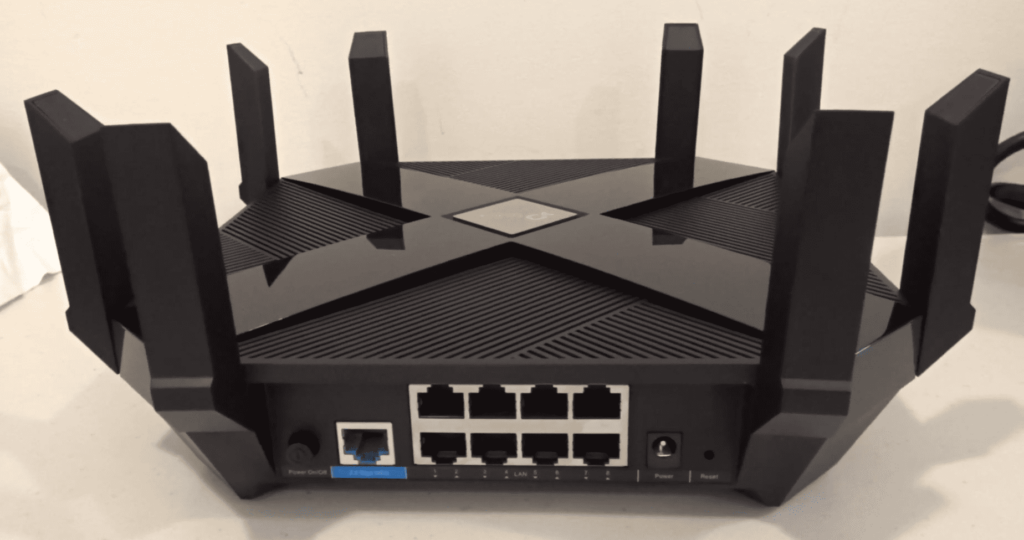
TP-Link outfits the router with eight LAN connectors that can handle up to Gigabit per second data flow and a WAN with a handling capacity of up to 2.5 Gbps.
You can aggregate two LAN ports for a peak flow of 2 Gbps, meaning most of your high-end online tasks are completed in a jiffy.
I didn’t have two separate connections, so I tested the maximum speeds on the multi-gig ports with an AT&T 2 Gbps internet plan. With a maximum recorded speed of 1.96 Gbps for downloads, my Online games bolted like a bullet. Alongside, two USB ports are there for faster file transfers.
WiFi Coverage & Devices Capacity
Tested in real-time setup, Archer 6000’s range turned out at 2,150 Sq Ft, which means it missed quite a few spots in my 2,500 Sq Ft test lab. Irrespective of that, the router seems a smart choice for any two-bedroom apartment or a home-based workspace.
During my test, it displayed an excellent penetration ability, and stable signals were accessible even three walls away.
The powerful antennas of Archer work with beamforming, OFDMA, and 4×4 MU-MIMO tech to help connect up to 47 smart devices at once. These include many bandwidth-hogging ones like smartphones, laptops, computers, and others.
Security Features
Security is the same as in Archer AX11000, and features like WPA3, VPN, guest network, SPI firewall, and access control boost your online security. Also, using the Tether app, you can add or remove any devices if needed.
Conclusion
With a plethora of ports and the ability to pair two of them to create a 2 Gbps data stream, Archer AX6000 leads with an example that routers can be good with cables as well as WiFi. To learn more about this device, look at its comprehensive review.
Pros
- Wi-Fi 6 standard
- Link Aggregation
- Excellent speeds
- Great WiFi range
- Easy to install
Cons
- No tri-band support
- Antennas are not adjustable
3. Best Mesh WiFi: Netgear Orbi RBK852
Do you need a strong, stable signal throughout your large home or office with thick walls or obstructions? It's better to establish a mesh network.
- Coverage up to 5,000 sq. ft. and for up to 100 devices. Extend coverage up to 2,500 sq. ft. with each additional satellite (sold separately)
- Ultrafast AX6000 gigabit speed with WiFi 6 technology for uninterrupted streaming, HD video gaming, and web conferencing
- NETGEAR devices come with security measures built in as well as enhanced safety features and updates designed to help protect you and your family
- Compatible with any internet service provider up to 2.5Gbps including cable, satellite, fiber and DSL
- Plug in computers, game consoles, streaming players, and more with 4 Gigabit Ethernet ports on the router and each satellite
Coming as a replacement for Orbi RBK752, the RBK852 lands in multiple upgrades like a powerful processor paired with 1GB RAM, higher throughput capacity, 5,000 Sq Ft range, tri-band frequencies, and more for much better performance.
Speeds & Performance
The Orbi RBK852 is a dual-band WiFi 6 mesh with a maximum data transmission ability of 6000 Mbps, and the respective band-wise speeds are as follows:
| 5 GHz (1): 2400 Mbps | 5 GHz (2): 2400 Mbps | 2.4 GHz: 1200 Mbps |
I knew the mesh WiFi was going to be strong, and the throughput results didn’t disappoint. The tests were carried out on a MacBook Pro and Xfinity Gigabit plan.
And the results: an eye-watering download and upload speeds of 906 Mbps and 38 Mbps, respectively, at a 30 feet distance. It doesn’t get much faster than that, making way for lag-free 4K streams, gaming, HD Zoom calls, web browsing, and more.
Besides moving over to 60 feet, the respective speeds drop to 634 Mbps and 29 Mbps but are ample to mow through your high-end online games and video streams.
Ports & Connectivity
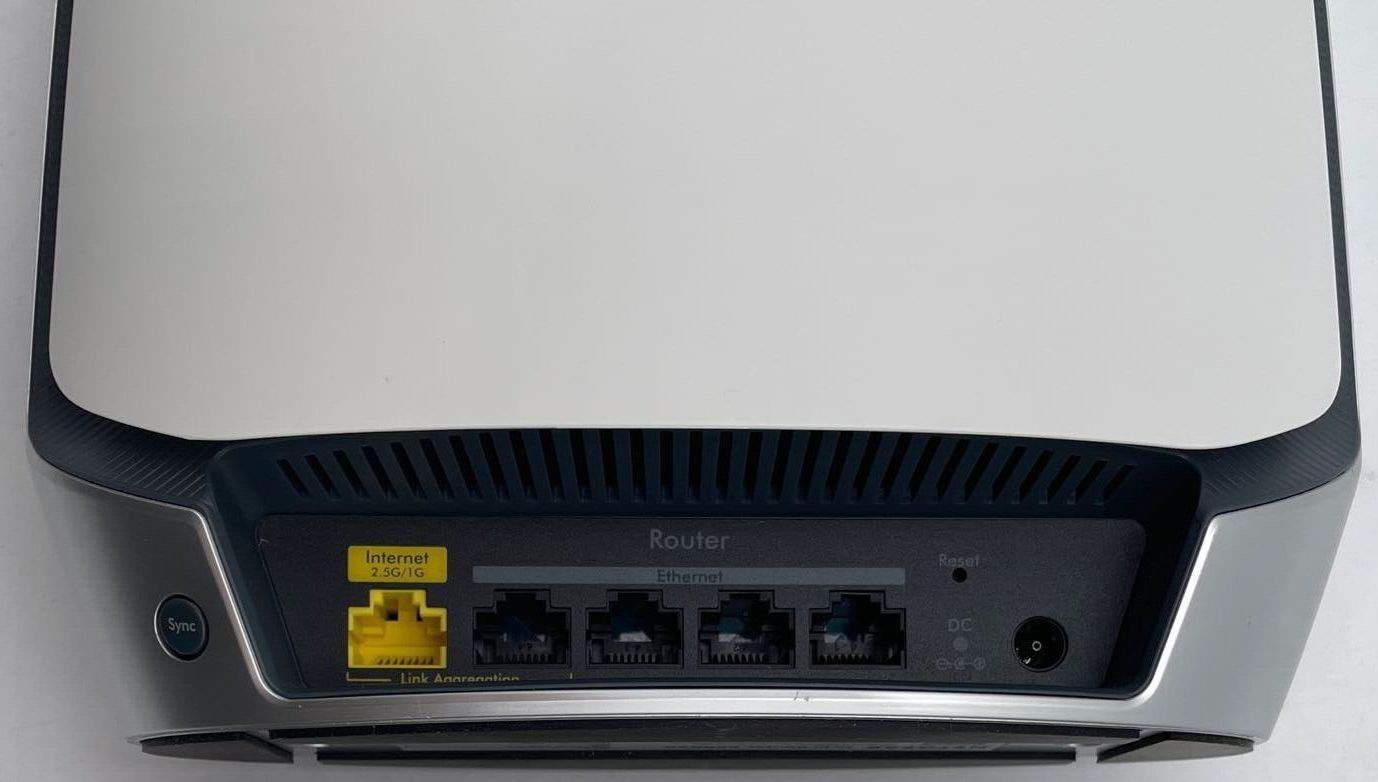
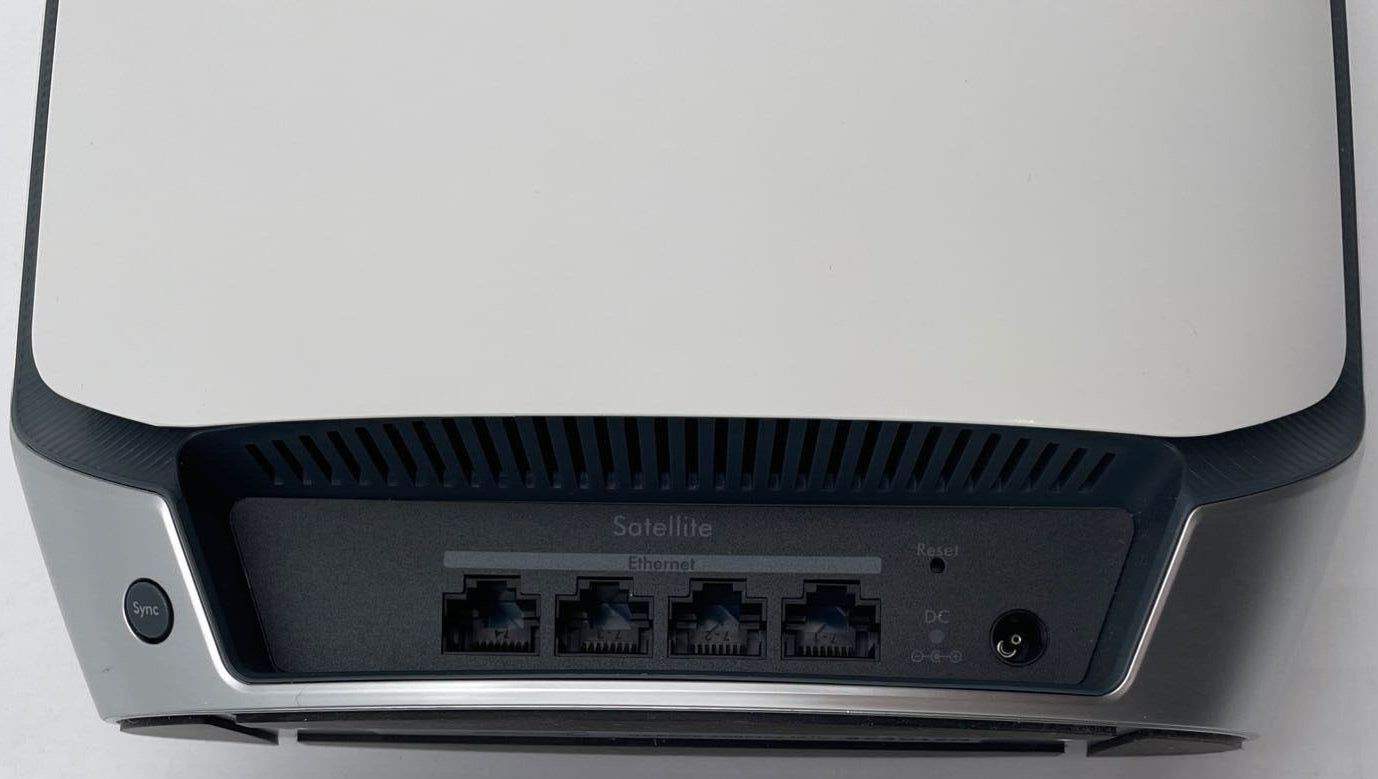
A single unit or the main router of RBK852 entails one 2.5G WAN and four 1 Gig Ethernet LAN ports for wired connections. Including a satellite adds four more 1 Gig LAN ports to the mix, bringing the total number to nine.
Although the Gig ports lack port aggregation support, a 1 Gbps connection yields maximum download and upload speeds of 934 and 43 Mbps, respectively. That’s suitable enough for your high-speed gaming needs.
WiFi Coverage & Devices Capacity
Mesh systems are known for their long range, and so is Orbi RBK852, with a stipulated value of 5,000 Sq Ft.
In my coverage tests, I managed to access strong signals over an area as large as 4,600 Sq Ft, which means my entire mansion-style home, yard, and distant garage were filled with strong signals.
The unit is further known to handle multiple devices (stipulated capacity of 100). With the integration of MU-MIMO and OFDMA, I could easily connect 73 devices, including laptops, computers, smartphones, and others.
Security Features
Netgear offers rather advanced security software, but it’s exclusive only for a premium monthly or yearly subscription.
Out of the box, there are some decent features like WPA3, VPN, guest network, network access, and auto-firmware updates to secure your network data. Besides, you can add or remove any device using the app if needed.
Conclusion
If your traditional router struggles to deliver signals to most parts of your house, then the Orbi RBK852 is a smart choice. With a tri-band setup, you get a fast throughput, and a great arrangement of ports lets you extend LAN connectivity.
But for these, you must pay a hefty upfront amount. For more details, check out the dedicated review of Orbi RBK852.
Pros
- Tri-Band Wi-Fi 6
- Excellent throughput
- Excellent WiFi coverage
- Decent security tools
- Easy to setup
Cons
- Premium price
4. Best for Gaming: ASUS RT-AX88U
- Next gen Wi-Fi standard 802.11Ax Wi-Fi standard for better efficiency and throughput; ultrafast Wi-Fi speed 6000 Mbps Wi-Fi speed to handle even the busiest network with ease.Power Supply : AC Input : 110V~240V(50~60Hz), DC Output : 19 V with max. 2.37 A current.
- Certified for Humans – Smart home made easy for non-experts. Setup with Alexa is simple.
- Wider usage and more convenience 4 antennas plus 8 LAN ports to support more clients at the same time
- Commercial-grade security – AiProtection powered by Trend Micro blocks internet security threats for all your connected smart devices
- Better partner with mesh system; compatible with ASUS AiMesh Wi-Fi system for seamless whole home coverage’s support: Windows 10, Windows 8, Windows 7, Mac OS X 10.6, Mac OS X 10.7, Mac OS X 10.8
Next on my list is the Asus RT-AX88U, which keeps up with the “gaming router” tag with many gaming-exclusive features.
A souped-up version of RT-AX86U, it brings in many upgrades in processing setup, range, throughput capacity, and port setup to improve performance overall.
Speeds & Performance
Asus RT-AX88U with WiFi 6 standard is an AX6000 router capable of transmitting data at the rate of 6000 Mbps, and the band-wise speeds are as follows:
| 5 GHz: 4804 Mbps | 2.4 GHz: 1148 Mbps |
What’s exciting part about the router is the pure performance it offers. With Spectrum 1 Gbps plan, I could achieve top download speeds of 894 Mbps and upload rate of 36 Mbps from a 20 feet distance.
That’s faster than most routers in this range. Staying in line with that, the router achieved 475 Mbps download and 24 Mbps upload. To break it down, the router can easily handle multiple 4K Netflix streams, video conferences, and many others.
So, for a very demanding family, it’s a smart pick. With these running in the background, features like game acceleration, game boost, and QoS let me play Overwatch at 16ms ping and 91 frame rates per second.
Ports & Connectivity
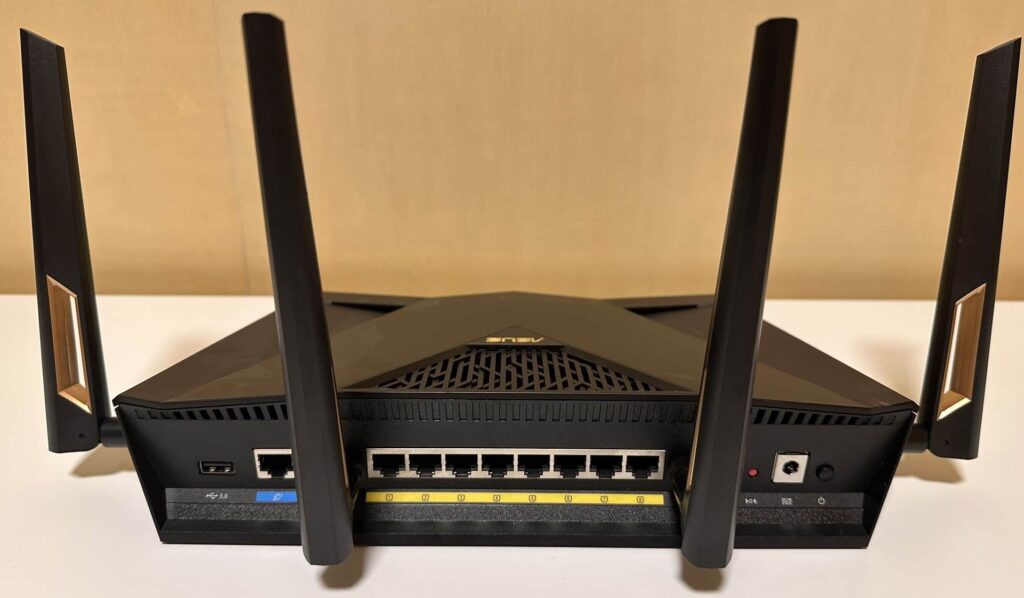
RT-AX88U doesn’t feature any multi-gig network port; at most, you’ll get 1 Gbps maximum speeds out of your wired connections.
But there are nine Ethernet ports (1 WAN and 8 LAN) with such an ability, and Spectrum Internet GIG plan got me a maximum download and upload speed of 947 Mbps and 41 Mbps for downloads and uploads.
Although there isn’t any multi-gig port, it supports link aggregation, and you can pair two Internet plans to get speeds of up to 2 Gbps. That’s a handy option to have.
WiFi Coverage & Devices Capacity
Range-wise, the RT-AX88U checks out in fine style again. My tests reveal that a device could maintain a connection up to 46 feet from the router or within a 2,100 Sq Ft area. That’s on par with the TP-Link Archer AX6000, and I would recommend it if you have a mid-sized apartment or workspace.
Its four-antenna setup, paired with MU-MIMO and beamforming, transmits signals strong enough to access up to 52 devices simultaneously. The numbers, however, differ with the kind of tasks you’re performing.
Security Features
The security of the Asus routers is probably the best amongst the rest with its lifetime-free Aiprotection pro, powered by Tenda Micro.
It offers a three-pronged security to block threats from all your devices. It carries out security scans regularly to block off malicious sites and infected devices. So you can stay on top of your online game without feeling threatened.
Conclusion
The RT-AX88U is an excellent choice if you’re a gamer and need fast throughput to solider through most bandwidth-intensive tasks in a jiffy.
Its powerful antennas let you enjoy such speeds on a large area and over multiple devices at once. But what’s best about it is lifetime-free AiProtection pro security software with advanced features. Read the full review.
Pros
- Robust QoS settings
- Built-in malware protection
- Speedy performance
- Easy to install and use
Cons
- No multi-gig port
5. Best for Small Businesses: TRENDnet TEW-829DRU
- HIGH PERFORMANCE AC3000 TRI-BAND WiFi: Three concurrent WiFi bands maximize device networking speeds: two separate high performance 802. 11ac networks up to 1733Mbps (5GHz1) + 867Mbps (5GHz2) + 400Mbps (2. 4GHz) bands.
- NDAA + TAA COMPLIANT: With our NDAA and TAA compliant Wireless AC, you can plan and install networking solutions that Government customers demand today (U.S. and Canada Only)
- MANUFACTURER PROTECTION: We stand by the quality of our products.The TEW-829DRU AC3000 Tri-Band Wireless Gigabit Dual-WAN VPN SMB Router is backed and supported with 3 years of TRENDnet Manufacturer Protection.
- RELIABLE TECH SUPPORT: Our team of advisors, support and tech experts are English speaking, and available for all your needs during normal business hours. We take pride in being there for our customers.
- PORTS AND ANTENNA GAIN: 2 x Gigabit WAN ports, 8 x Gigabit LAN ports, 1 x USB 3. 0 port, 1 x Console port. 2. 4 GHz: 2 x 2. 9 dBi (max. ) / 5 GHz: 4 x 4. 4 dBi detachable/external
Last but not least, presenting you with a Wi-Fi 5 based TRENDnet TEW-829DRU with a tri-band setup, ten Ethernet ports, powerful antennas, and other networking technologies to establish a reliable and speedy connection throughout the space.
I tested it alongside TRENDnet TEW-827DRU, and courtesy of improved throughput, band setup, range, and others, I got a much better performance.
Speeds & Performance
With a tri-band WiFi 5 setup, TRENDnet TEW-827DRU has an aggregated speed of 3000 Mbps, split between each band as follows:
| 5 GHz (1): 1733 Mbps | 5 GHz (2): 867 Mbps | 2.4 GHz: 400 Mbps |
I tested it across multiple scenarios, and the results were more of a mixed bag. At close range, the device averaged 813 Mbps and 34 Mbps, respectively, for downloads and uploads with the Xfinity Gigabit plan.
While moving further at 40 feet resulted in 425 Mbps download and 26 Mbps upload speeds. The speed drop was noticeable, especially at distances; tasks like sending emails, streaming HD shows & music, browsing, and others were still feasible.
Besides, the device provides QoS support for traffic prioritization and better gaming or streaming performance.
Ports & Connectivity
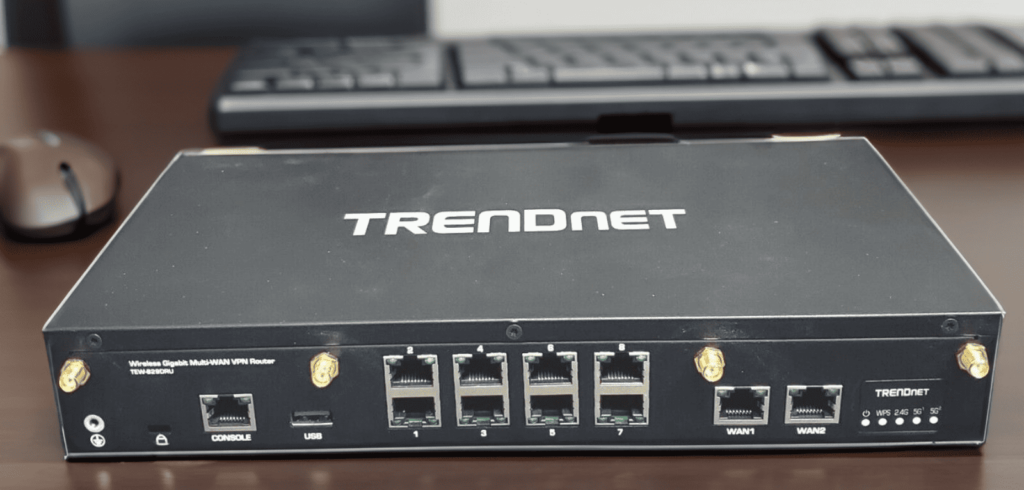
On the rear side, there’s a USB 3.0 port, ten network ports (8 LAN & 2 WAN), all gigabit on the front. It means you can add numerous devices at once and experience speeds of up to 992 Mbps and 981 Mbps for downloads and uploads. However, no multi-gig port or link aggregation support exists for higher Gigabit speeds.
WiFi Coverage & Devices Capacity
The range of TEW-827DRU was a bit underwhelming than others with a stipulated value of 2,000 Sq Ft. When placed in the middle, it could even cover some 1,760 Sq Ft of residential settings with a decent WiFi signal, courtesy of its six antenna support.
Paired with it, the MU-MIMO tech helps connect up to 23 smart devices at once. It even includes my top-draw devices like laptops, computers, and smartphones.
Security Features
The security of TRENDnet is rather interior, especially when you compare it with the Asus RT-AX88U. It only has basic features like WPA2, VPN, and guest network, which can keep the network data packets safe. So, if you need your devices to stay secure, I’d recommend subscribing to a third-party antivirus.
Conclusion
The TEW-829DRU doesn’t have much to qualify as an excellent routing device, but its features and performance make it reliable for most network setups. Its speed, range, and device handling will get the job done, but its ten-port setup is what makes it an ideal small business router.
Pros
- Solid heavy-duty design
- 10 Gig-E ports
- Great speeds
- Decent range
Cons
- No multi-gig ports on link aggregation
Frequently Asked Questions
Eight-port wireless routers are there for you to establish many wired connections if you need interference-free connections on your device. So, if your setup qualifies for that, it’s worth getting an 8-port router.
You can plug in your bandwidth-intensive devices to these to experience higher speeds without interfering with each other’s bandwidth.
Here are a few things to look into:
1. Type of ports, maximum speed cap of each, and whether they support link aggregation
2. Maximum speeds the router offers
3. Range is optional, but you must connect wirelessly to a router
4. Number of devices the router can handle at a time
5. Cost at which it comes in
Verdict
With that comes an end to my reviews. Not only port setup, you must look into other features and the router's wireless performance. If you're still confused and unable to choose an ideal 8-port WiFi router, here are my final suggestions:
- If you need the best option regarding speed, coverage, device-handling ability, and port setup, TP-Link AX11000 is an ideal pick.
- If you can compromise a bit on speed and WiFi 6E, go for its sibling Archer AX6000.
- For the budget yet reliable pick, go for the ASUS RT-AX88U.







